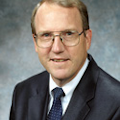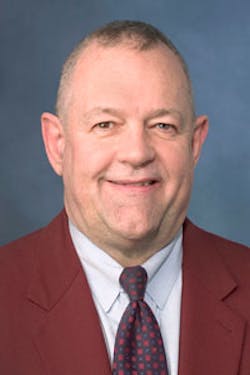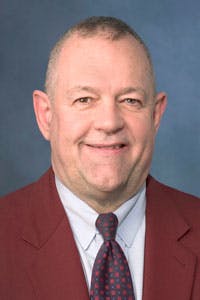New SEG president is group's first near-surface specialist
Election of the first specialist in near-surface geophysics to lead the Society of Exploration Geophysicists raises a communications problem: The definition of "near surface," says new SEG Pres. Don Steeples, depends on application.
In groundwater remediation, he explains, the near surface is the upper 200-300 ft of the earth. In solid-earth geophysics, it's the upper 20,000-30,000 ft. In oil and gas, it's the upper 500-1,000 ft.
It was not by plan that much of the new SEG president's research and consulting work has concentrated on that last depth range. When Steeples, the Dean A. McGee distinguished professor of geophysics at the University of Kansas, started studying the subject, his main interest was groundwater exploration. A couple hundred projects later, he still hasn't explored for groundwater. Research funding steered him toward oil and gas.
"I sort of went where the money was," explains Steeples, who became SEG president at the association's annual meeting last month after his election a year earlier.
The holder of a PhD in geophysics from Stanford University, he first studied salt-dissolution sinkholes associated with oil field activity in central Kansas. That led to tunnel-detection research for the military, mostly near international borders. In the early and mid-1980s, Steeples worked to improve bedrock maps for environmental problems, helping Phillips Petroleum Co. predict flows of pollutants containing water. At about that time he looked for shallow underground faults associated with earthquake risk in the West.
He also has done work related to underground utilities.
Many uses
Obviously, near-surface geophysics has many uses. For oil and gas, Steeples explains, most of them relate to static corrections: accounting for surface irregularities and shallow, unconsolidated material in what's known as the weathered layer. Static corrections establish a datum plane against which sound-reflection times are measured in seismic surveys targeting deeper strata.
Steeples describes static correction as "wiping the fog off the mirror," necessary "if you really want to see the clear image down deeper." Near-surface geophysics, he says, "provides a detailed look through that upper few hundred feet to correct the image deeper." A typical near-surface survey produces a detailed velocity model for use by seismic processors interested in deeper reflecting horizons.
The "classic" energy source for a near-surface seismic survey onshore, Steeples says, is a sledgehammer. But he has done more work with a rifle than with any other source.
"I've done a lot of work with a .22 and a .30-06," he says. He also has used a .50-cal. machine gun.
Shallow seismic surveys use a single geophone for each channel. The number of channels has increased from eight in past years to 480 or more now. Advances in near-surface methods have to do mainly with the availability of cheap, reliable equipment.
Shallow seismic surveys can be supplemented by data from ground-penetrating radar, which is effective down to a few tens of feet.
"The capability of doing near-surface geophysics is there now that wasn't 20 years ago for some people because of cost," Steeples says.
While his work has been onshore, others have conducted near-surface geophysical operations offshore. Steeples points to shallow marine work in the Bristol Bay of Alaska conducted to assist in the design of drilling platforms.
The new SEG president has consulted for more than 50 oil and gas companies and service firms but never has been employed by any of them. He thinks he might be the first SEG president with that employment record.
SEG focus
His expertise in near-surface methods fits a stated effort by the association to expand its work in the area. It has created a Near-Surface Task Force and approved funding of a Near-Surface Honorary Lecturer. Among its aims are to add near-surface specialists as members and to boost hydrogeophysical applications in response to the importance of water sourcing and handling in the development of unconventional resources.
The effort remains in early stages.
"The majority [of members] are not interested or not aware," Steeples acknowledges. His election followed his fourth nomination for the SEG presidency.
"Persistence and name recognition probably made some difference," he says, noting that he was editor of Geophysics, a bimonthly journal published by SEG, during 1989-91. "That gets you quite a bit of name recognition."
Also, as SEG Distinguished Lecturer in 2007, Steeples discussed what he describes as "entertaining" shallow-seismic experiments. "People remembered the .50-cal. machine gun," he says.
The rest of his SEG record is extensive: serving four times on the annual meeting Technical Program Committee, last year as chair; leading the Committee on Digital Publications; and serving on the Engineering and Groundwater Committee, Publications Committee, SEG-AAPG Joint Committee on the 3D Seismic Atlas, and Industry/Academic Committee. He also was a continuing education instructor and first president of SEG's Near-Surface Geophysics Section, serving on that group's executive committee in 1993-95; the section awarded him honorary life membership in 2008. The SEG Executive Committee, on which he served during 1989-91 while editor of Geophysics, gave him its Frishknecht Award in 1996. He is one of only nine recipients of both life membership and honorary membership from SEG.
In the last 10 years, Steeples hasn't conducted much research. He became vice-provost for scholarly support at the University of Kansas in 2003, overseeing the work of 700 employees. He stepped down from that position 3 years ago and describes his current status at the university as "phased retirement."
Seismic advances
Asked about important areas of seismic advance outside his specialty, the new SEG president points to microseismic recording, which is "a whole lot bigger now than it was 10 years ago." In that method, instruments on the surface or in a wellbore record unreflected sound emanating from the subsurface.
Microseismic recording can help operators monitor fractures during a frac job. It also can monitor unintended earthquakes, such as the weak ones resulting from fracturing and sometimes larger ones triggered by the injection of wastewater into disposal wells.
Another use of microseismic recording is passive-seismic surveys, in which, Steeples says, "you set out recorders and see what you can extract from the natural seismic noise in the ground."
Steeples also notes improvements in 4D surveys—sequential 3D surveys that can record reservoir changes that occur over time as a result of production of oil and natural gas.
Instrumentation has improved, too, he says. And computing power "continues to increase exponentially, as does the need for it."
For near-surface geophysics, Steeples expects steady acceptance by oil and gas operators and contractors, explaining, "Any time they can see a way to enhance the bottom line they'll jump on it."
The observation leads Steeples to a distinction between two functional areas with which he has great experience: The oil industry aims first to maximize profit; environmental remediation aims first to minimize loss.
"There's quite a difference between those two perspectives," he says.
About the Author

Bob Tippee
Editor
Bob Tippee has been chief editor of Oil & Gas Journal since January 1999 and a member of the Journal staff since October 1977. Before joining the magazine, he worked as a reporter at the Tulsa World and served for four years as an officer in the US Air Force. A native of St. Louis, he holds a degree in journalism from the University of Tulsa.

